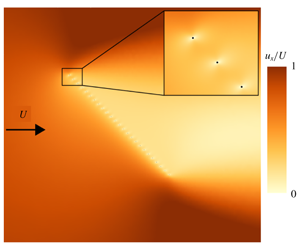Article contents
Optimal configuration of a two-dimensional bristled wing
Published online by Cambridge University Press: 07 February 2020
Abstract

In contrast to common continuous wings, microscopic flying insects such as fairyfly and thrips possess extraordinary wings that comprise several bristles. In the low-Reynolds-number environment inhabited by these insects, a bristled wing benefits from the formation of virtual fluid barriers that prevent flow leakage in the gaps of bristles. In this study, the optimal configuration regarding the aerodynamic performance of simple bristled-wing models is investigated numerically in terms of the Reynolds number and the distance between bristles, which are known to be important parameters for determining the effectiveness of a virtual fluid barrier. Inspired by the inherent characteristics of low-Reynolds-number flow, we provide new insights into the aerodynamics of a bristled wing by using a scaling parameter that combines these two independent parameters: effective gap width. In addition, the force ratio is scaled with the Reynolds number to better characterize the generation of drag and lift by a bristled wing. Despite the Reynolds number and the gap width varying by several orders of magnitude, the scaled drag force converges asymptotically beyond a specific effective gap width, and the lift force ratio has a peak within a very narrow range of the effective gap width. The trend of the lift with the effective gap width is correlated with changes in the asymmetric distributions of pressure and vorticity on the surface of the bristles. In addition, the drag and lift predicted theoretically, by invoking the linear superposition of creeping flows, agree well with numerical results, in particular for large effective gap width.
JFM classification
- Type
- JFM Papers
- Information
- Copyright
- © The Author(s), 2020. Published by Cambridge University Press
References
- 24
- Cited by


